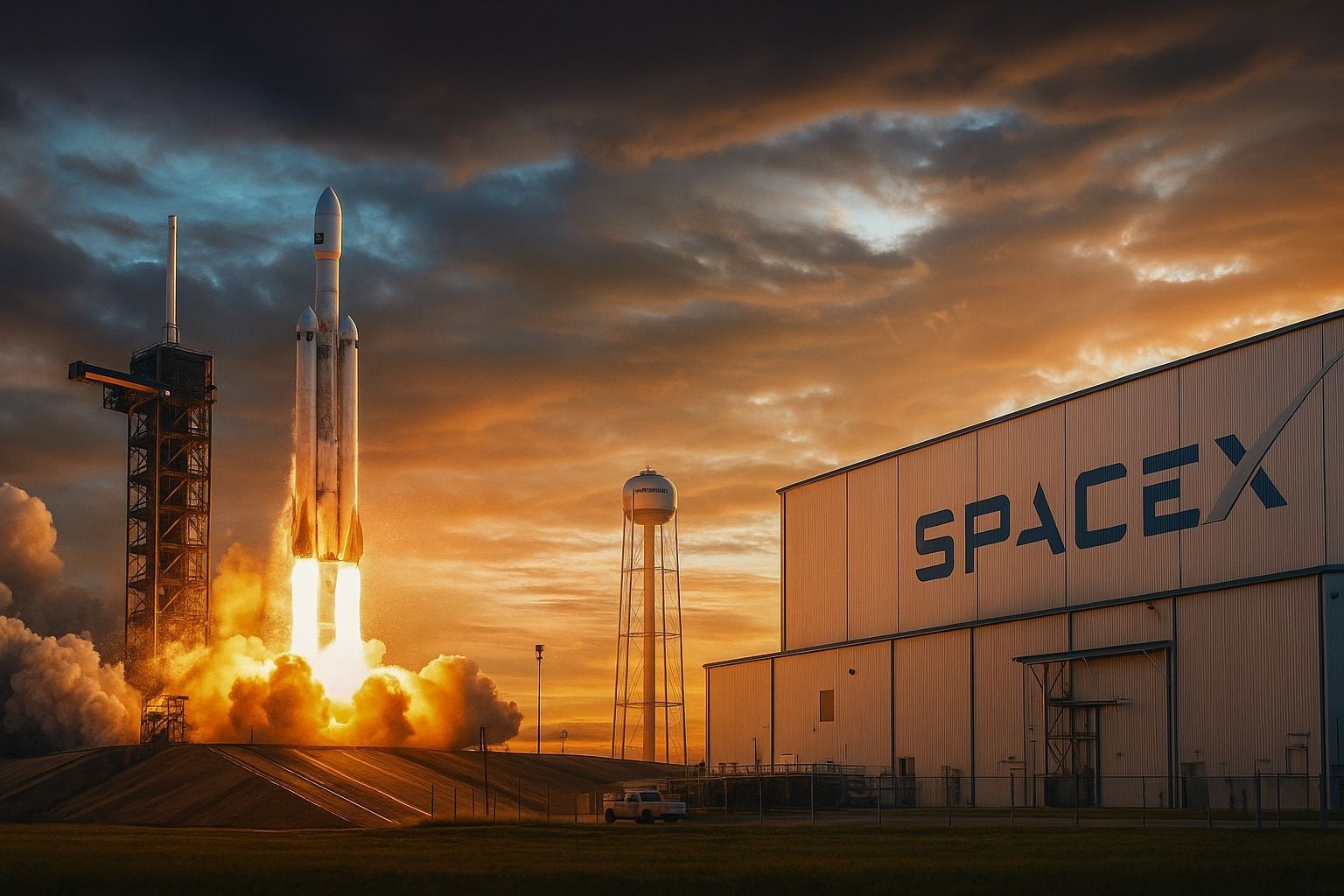Canadian space-tech champion MDA Space faces a brutal rerating after EchoStar’s $1.3 billion contract cancellation and SpaceX‑linked customer buzz – just as it reports surging Q3 revenue, reaffirms guidance, and announces a futuristic wireless power partnership.
MDA Space (TSX:MDA) stock has more than halved amid SpaceX-related contract turmoil and Globalstar sale rumours. On 14 November 2025, the company posted strong Q3 2025 results, reaffirmed guidance and highlighted a new wireless power partnership. Here’s what today’s news means for TSX:MDA investors.
MDA Space stock halves in a month as SpaceX ripples through its customer base
MDA Space Ltd. (TSX:MDA; OTC:MDALF) has gone from market darling to cautionary tale in a matter of weeks.
- The Toronto‑listed shares closed at approximately C$21.43 on 13 November 2025, well below a 52‑week high around C$48, leaving the stock more than 55% off its peak and roughly 44% lower than its recent 30‑day high. [1]
- Over the last 30 and 90 days, MDA’s share price has delivered ‑41.99% and ‑52.47% returns, respectively, according to Simply Wall St’s latest valuation note published today. [2]
A new note on Seeking Alpha this week bluntly describes the move as a “SpaceX‑induced” stock price hit, arguing that MDA shares are now pricing in worst‑case scenarios and could offer roughly 66% upside from current levels if those fears ease. [3]
What actually triggered the selloff?
Two intertwined stories sit behind the rout:
- EchoStar cancels a US$1.3 billion constellation contract and sells spectrum to SpaceX
- In early September, MDA disclosed that EchoStar had terminated “for convenience” a planned US$1.3 billion direct‑to‑device (D2D) satellite constellation contract. [4]
- EchoStar simultaneously agreed to sell key AWS‑4 and H‑block spectrum licences to SpaceX in a US$17 billion cash‑and‑stock deal aimed at boosting Starlink’s network. [5]
- MDA has said EchoStar will owe termination liabilities and that the work already done will feed into an improved 5G‑ready AURORA satellite design – but equity markets focused on the lost backlog and the signal that big constellation buyers may pivot toward SpaceX. [6]
- Globalstar sale rumours and SpaceX interest deepen the anxiety
- Late October reporting from Bloomberg and others suggested Globalstar is exploring a sale, with SpaceX named as one of the potential buyers. [7]
- In its recent Q3 update, Globalstar also revealed that MDA and Rocket Lab are running behind schedule on a 17‑satellite constellation, with launches on SpaceX Falcon 9 rockets now pushed into 2026 and potential liquidated damages looming. [8]
- Together, these developments stoked fears that key MDA customers might be pulled closer into SpaceX’s orbit, either via M&A or via tighter integration of satellites and launch with SpaceX’s in‑house manufacturing.
As the rumours swirled and the stock free‑fell in late October, MDA took the unusual step of issuing an Oct. 30 “market update”. The company said its share price volatility appeared to be driven by “unconfirmed and speculative media reports related to mergers and acquisitions in our customer base”, and stressed it would not comment on rumours but would provide a fuller update with its Q3 results on 14 November 2025. [9]
Today is that day – and the numbers matter.
Q3 2025: Strong top‑line growth, softer bottom line
On 14 November 2025, MDA Space released its third‑quarter 2025 results, giving investors the first hard data point since the SpaceX‑EchoStar shock and the Globalstar chatter. [10]
Key highlights from the quarter ended 30 September 2025:
- Revenue:
- Q3 revenue came in at C$409.8 million, up about 45% year‑over‑year from roughly C$282.4 million, driven primarily by higher volumes in the Satellite Systems and Robotics & Space Operations segments. [11]
- Backlog and visibility:
- MDA reported a backlog of C$4.4 billion, only slightly below C$4.6 billion a year ago, providing substantial revenue visibility into 2025 and beyond despite the EchoStar termination. [12]
- Profitability:
- Adjusted EBITDA reached C$82.8 million, up nearly 50% year‑over‑year, with margins around 20.2%, broadly consistent with the company’s full‑year margin guidance of 19–20%. [13]
- IFRS net income, however, fell to C$24.4 million from C$29.5 million a year earlier, as financing costs and non‑cash items offset the stronger revenue base. [14]
- Balance sheet and cash:
- Operating cash flow for the quarter was about C$32.8 million, and net debt sat at roughly 0.3x adjusted EBITDA, leaving the company with meaningful balance‑sheet flexibility. [15]
- Guidance:
- Importantly for credibility, MDA reaffirmed its full‑year 2025 financial outlook, signalling that management believes the current order book and pipeline can offset contract noise. [16]
Alongside the numbers, management pointed to a series of strategic wins in 2025: completing the acquisition of SatixFy Communications, demonstrating an industry‑first digital beam‑forming capability with its AURORA platform, securing new defence and space‑situational‑awareness contracts, and being named 2025 Global Satellite Business of the Year and recognized as a TSX30 company. [17]
In other words, operationally the story remains very strong, even as investors digest the changed risk profile around key customers.
New wireless power partnership with Bumblebee Power
Today’s news cycle isn’t just about earnings. Another headline on 14 November 2025 is catching the eye of growth‑oriented investors: MDA’s new wireless power partnership.
A fresh analysis from Simply Wall St notes that MDA Space has announced a collaboration with Bumblebee Power to develop high‑frequency inductive wireless power transfer systems for space applications. [18]
According to that report:
- The technology aims to beam power wirelessly to spacecraft and surface assets, targeting use‑cases where lunar dust, harsh environments and unreliable physical connectors make traditional cabling risky.
- The partnership underscores MDA’s push into next‑generation infrastructure for lunar and deep‑space missions, complementing its roles in robotics, satellite buses and geointelligence.
For investors, the Bumblebee deal is less about near‑term revenue and more about optionality:
- It strengthens MDA’s positioning in in‑space infrastructure, a theme gaining traction as agencies and private players plan lunar bases, orbital depots and multi‑satellite power networks.
- It reinforces the perception that, despite recent contract drama, MDA remains on the cutting edge of space‑tech innovation.
Valuation after the selloff: discount or value trap?
So where does the stock sit after the dust‑up?
Simply Wall St: Narrative fair value nearly double today’s price
In its 11/14/2025 piece, Simply Wall St frames MDA as a stock whose “story” and valuation have become disconnected: [19]
- A popular narrative model on the platform estimates “fair value” at about C$44.08 per share, versus a last close near C$21.43, implying the shares could be over 50% undervalued if those assumptions play out.
- That narrative assumes MDA’s revenue could reach around C$2.5 billion by 2028, with profit margins trending toward the high single digits or low double digits – numbers broadly in line with the company’s recent high‑growth trajectory and 20% EBITDA margin. [20]
- The same analysis also flags concentrated exposure to government contracts and the risk of timing shifts in programmes like NASA’s Artemis as key downside factors.
Simply Wall St also runs a more conservative discounted cash flow (DCF) scenario which suggests MDA may actually be trading above DCF fair value, underscoring the uncertainty around long‑term assumptions. [21]
Seeking Alpha: SpaceX shock as a “strong buy” opportunity
The high‑profile Seeking Alpha article titled “MDA Space: SpaceX‑Induced Stock Price Hit Provides Strong Buy Opportunity” leans even more bullish. [22]
In summary, that piece argues:
- MDA’s nearly 50% share price collapse is primarily linked to EchoStar cancelling its constellation contract and fears that a SpaceX‑Globalstar deal could threaten another major customer.
- Yet, with backlog still above C$4.4 billion, Q3 revenue up 45% and margins holding near 20%, the underlying business appears intact.
- The author’s upside case calls for roughly 66% share price appreciation from current levels, assuming MDA successfully replaces lost work and continues to win D2D and 5G constellation business.
To be clear, that’s one analyst’s view, not investment advice – but it illustrates how sharply market sentiment and fundamental momentum have diverged.
How the TSX Composite and analysts are reacting
A detailed feature from Kalkine Media this week, titled “TSX Composite Index Reacts To MDA Space (TSX:MDA) Canadian Performance,” situates the drama within the wider Canadian market. [23]
Key points from that coverage:
- MDA’s business spans robotics, satellite systems and geointelligence, with its AURORA software platform serving as a digital backbone for satellite operations.
- The stock has traded in a very wide range, reflecting both rapid growth and higher perceived risk compared with more mature industrials in the S&P/TSX Composite and TSX Smallcap indices.
- The article highlights recent insider transactions, including share sales by directors John Risley and Brendan Paddick, while noting they still retain significant holdings.
On the sell‑side, the same piece aggregates seven brokerage views:
- Houses like Canaccord Genuity and BMO Capital Markets have recently reduced their price targets or ratings, citing contract uncertainty and customer concentration risks.
- Stifel Canada has moved more positive, pointing to operational strength and growth in digital satellite systems.
- Scotiabank and RBC maintain broadly constructive stances, though RBC has reportedly trimmed its expectations in light of the EchoStar news. [24]
Data compiled by MarketBeat and other aggregators still shows an overall “Buy” consensus on MDA Space, albeit with a wider dispersion of targets than earlier in the year. [25]
Key risks investors are pricing in
Even after today’s strong Q3 print, the market is clearly discounting several tangible risks:
- Customer concentration and contract risk
- EchoStar’s decision to kill a multi‑billion‑dollar satellite deal just weeks after signing it – in order to monetise spectrum via SpaceX – has reminded investors how quickly constellation economics can change. [26]
- Globalstar’s disclosed delays and potential penalties underscore execution risk on complex programmes. [27]
- SpaceX as both partner and potential competitor
- SpaceX is increasingly a vertically integrated behemoth – running launch, satellites and services under one roof.
- If key MDA customers such as EchoStar or Globalstar deepen ties with SpaceX, there is a risk that future satellite hardware and systems work could be internalised rather than sourced from incumbents like MDA.
- Programme timing and political risk
- MDA’s government and agency business – spanning defence, Earth observation and exploration – exposes it to budget cycles, programme delays and shifting priorities, including potential timing changes around Artemis‑related work. [28]
- Execution on growth initiatives
- The company is scaling quickly: integrating SatixFy, ramping AURORA digital beams, delivering multiple constellations and breaking into new areas like wireless power.
- With revenue growth running at ~45–50% year‑over‑year, the bar for flawless execution is high. [29]
- Valuation uncertainty
- As Simply Wall St’s opposing narrative vs. DCF views make clear, small tweaks in long‑term assumptions (growth, margins, discount rates) drastically change the “fair value” outcome. [30]
What today’s news means for MDA Space stock
Putting it all together, 14 November 2025 is a pivotal checkpoint in the MDA Space saga:
- The core business is still growing rapidly, with Q3 revenue jumping 45% and EBITDA margins holding at ~20%. [31]
- The company has reaffirmed its 2025 outlook, signalling confidence that its backlog and pipeline can navigate the EchoStar and Globalstar turbulence. [32]
- A new wireless power partnership with Bumblebee Power underscores that MDA is not standing still technologically, but expanding into high‑potential niches that could matter for lunar and deep‑space infrastructure. [33]
- Yet, the stock remains more than 50% below its highs, reflecting legitimate concerns about customer concentration and the rise of SpaceX as a direct competitor for both spectrum and satellites. [34]
For some analysts and quant models, that disconnect spells opportunity; for more cautious investors, it suggests a classic value‑trap risk where headline growth obscures a structurally tougher competitive landscape.
Either way, today’s earnings and partnership updates provide much‑needed fundamentals to weigh against the rumours.
Important: This article is for information and news purposes only and does not constitute financial advice or a recommendation to buy or sell any security. Investors should consider their own objectives and risk tolerance and, if needed, consult a licensed financial adviser before making investment decisions.
Quick FAQs: MDA Space, SpaceX and the recent selloff
Why did MDA Space stock crash in late 2025?
The selloff followed EchoStar’s cancellation of a US$1.3B D2D constellation contract with MDA and a subsequent US$17B spectrum sale to SpaceX, plus Bloomberg‑reported rumours that Globalstar is exploring a sale and has spoken with SpaceX. These moves raised fears that key MDA customers could shift future satellite work toward SpaceX or defer projects, prompting a sharp rerating. [35]
What did MDA report in Q3 2025?
On 14 November 2025, MDA announced Q3 revenue of C$409.8M (up ~45% YoY), adjusted EBITDA of C$82.8M (~20% margin), net income of C$24.4M (down vs. last year), backlog of C$4.4B, and reaffirmed its full‑year 2025 outlook. [36]
What is the Bumblebee Power partnership?
MDA recently teamed up with Bumblebee Power to develop high‑frequency inductive wireless power transfer systems for space, targeting scenarios where dust, harsh environments and mechanical connectors make conventional cabling unreliable. It’s an early‑stage, innovation‑driven partnership, not yet a major revenue contributor. [37]
Is MDA Space considered undervalued now?
Some models say yes, others are more cautious. Simply Wall St’s narrative framework pegs fair value near C$44 per share, more than double the recent close, while its DCF model is more conservative. A Seeking Alpha note sees roughly 66% upside after the selloff. But these are scenario‑based opinions, not guarantees, and they rely heavily on long‑term assumptions around growth and margins. [38]
References
1. stockinvest.us, 2. simplywall.st, 3. seekingalpha.com, 4. mda.space, 5. www.reuters.com, 6. mda.space, 7. www.reuters.com, 8. www.satellitetoday.com, 9. www.prnewswire.com, 10. markets.ft.com, 11. markets.ft.com, 12. markets.ft.com, 13. markets.ft.com, 14. ca.finance.yahoo.com, 15. markets.ft.com, 16. markets.ft.com, 17. markets.ft.com, 18. simplywall.st, 19. simplywall.st, 20. simplywall.st, 21. simplywall.st, 22. seekingalpha.com, 23. kalkinemedia.com, 24. kalkinemedia.com, 25. www.marketbeat.com, 26. mda.space, 27. www.satellitetoday.com, 28. simplywall.st, 29. markets.ft.com, 30. simplywall.st, 31. markets.ft.com, 32. markets.ft.com, 33. simplywall.st, 34. stockinvest.us, 35. mda.space, 36. markets.ft.com, 37. simplywall.st, 38. simplywall.st








